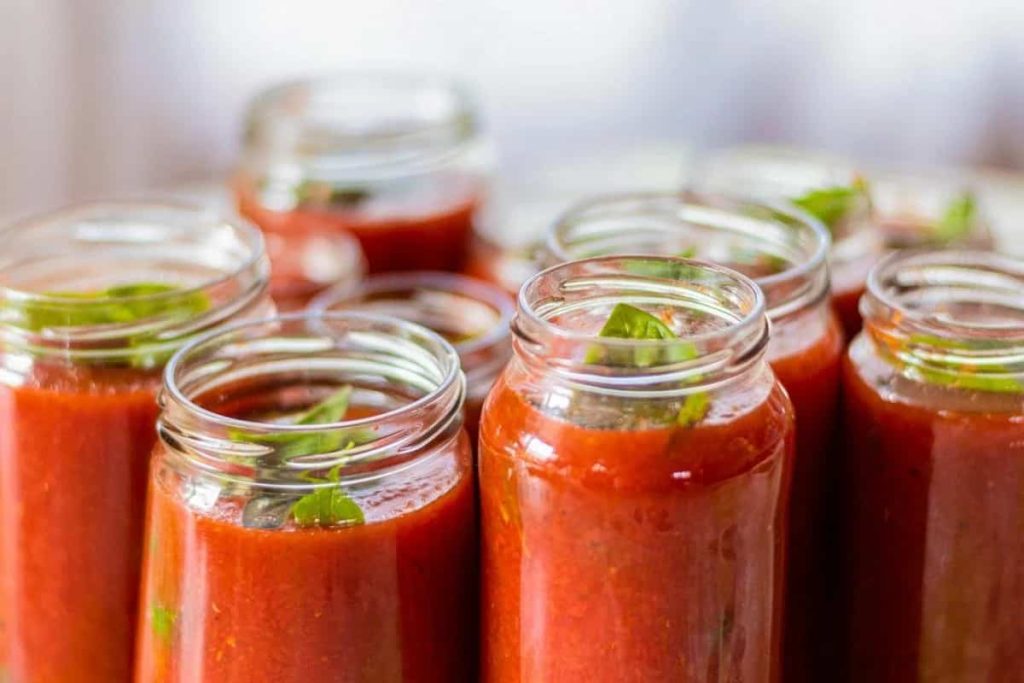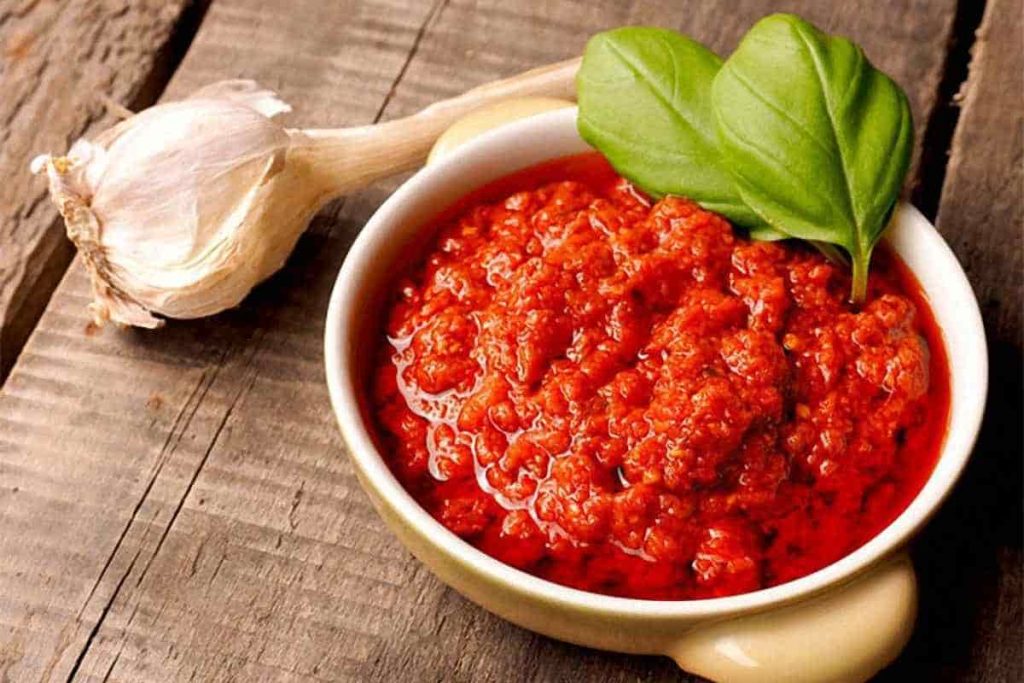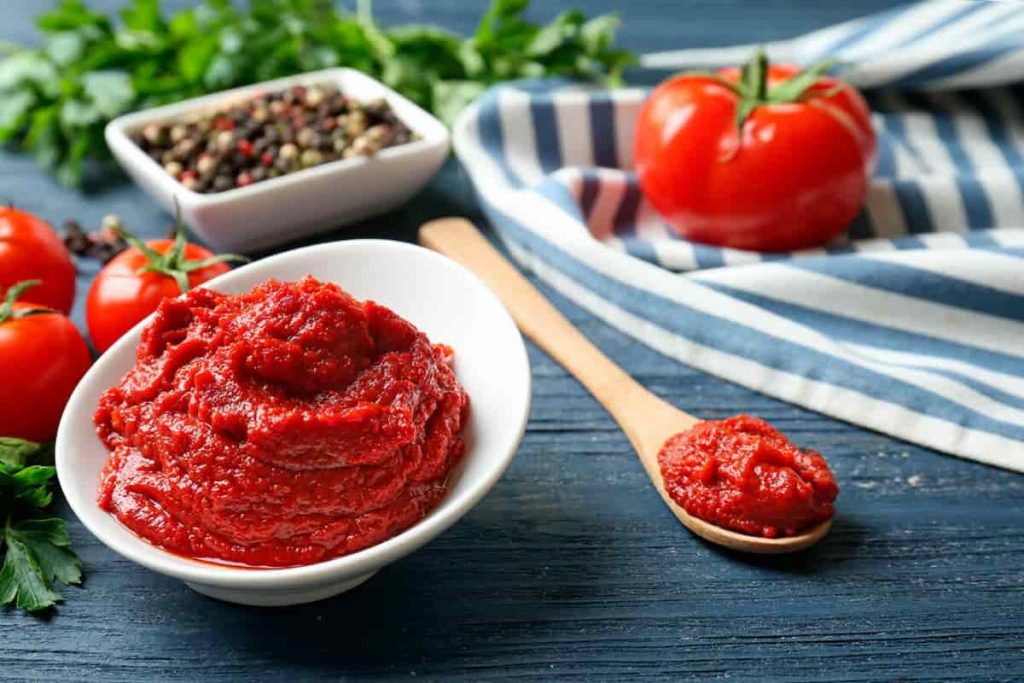Let’s compare the paste and sauce of tomatoes based on their ratio. To have a better understanding keep reading.
What proportion of tomato paste should I use?
You are in luck if you already have a jar of tomato paste in your kitchen cupboard because this is the most suitable alternative to tomato sauce.
Only tomato paste and water are required for this recipe. Combine tomato paste with water in a ratio of 1 to 1, and stir the mixture until it is smooth.
Tomato Paste Vs. Tomato Sauce:
In the kitchen, tomato paste and tomato sauce are frequently confused for one another, but they are two distinct ingredients. In reality, they are the same.
Some of you might not be able to differentiate between tomato paste and tomato sauce at first glance; nonetheless, these two products are distinct in terms of their flavors, consistencies, applications, and methods of preparation.
In this piece, I’ll assist you to differentiate between these two multipurpose components of your kitchen so that you can apply them most effectively and learn how to bring about the best outcomes possible with them.
Tomato Paste Versus Tomato Sauce:
Tomato paste and sauce have several characteristics, including their hue, their consistency, some of the components required to prepare them, and the fact that they may both be used as an effective marinade to enhance the flavors of certain dishes.
On the other hand, if you give it some more thought, you’ll realize that tomato paste has a meatier flavor and a more viscous consistency, whereas tomato sauce tastes more like fresh tomatoes and has a thinner consistency.
Tomato sauce and tomato paste are both nutritious when they contain a lot of tomatoes, however tomato paste has a higher concentration of nutrients than tomato sauce does because of its thicker consistency.
What Does Tomato Paste Consist Of?Historically, tomato paste, which is just concentrated solid tomato, was produced in Sicily, southern Italy, and Malta by reducing tomato sauce until it reached a dense consistency and then sieving the sauce.
In the early part of the 20th century, tomato paste was introduced to the public for the first time; since then, it has evolved into one of the most spectacular components of your recipes.

Every dish you prepare, when you add tomato paste to it, will have more powerful flavors, a richer texture, and increased wetness; as a result, your dishes will be delectable.
What do you think of the flavor? Because it may impart a flavor similar to that of meat, tomato paste has gained widespread popularity all over the world.
In addition, tomato paste has a raw taste that is characterized by lively acidity and an umami flavor, all of which make it an excellent flavoring for dishes such as pasta, meatloaf, or taco filling.
In addition, tomato paste is an essential component in a wide variety of recipes, including slow-cooker butter chicken, sloppy joes, and many other types of soup, where it is used to impart a robust amount of tomato flavor as well as to make the dish more nutrient dense and healthy. Zucchini fries are an excellent side dish for people who are following keto diets.
If you were to compare tomato paste to fresh tomatoes, which would you say is the healthier option? If I had to guess, I’d think that the nutritious worth of either is roughly comparable; however, when you take into account the flavor, tomato paste is likely to be significantly more enjoyable and reassuring.
What Kind of Nutrition Does Tomato Paste Offer?
You are aware that tomato paste is prepared using tomatoes and is just as nutritious as tomatoes themselves, but how exactly is this the case? The following is a list of benefits that tomatoes can provide to your body’s health.
Tomatoes, as you are aware, are an excellent source of vitamins A, K1, and B9, in addition to minerals that are beneficial for preventing heart disease, blood clotting, bone health, and even for women who are pregnant.
Surprisingly, processed tomatoes and tomato products like tomato paste and tomato sauce have a high concentration of the potent antioxidant lycopene, which is known to improve cardiovascular health and lower the chance of developing certain types of cancer.
What exactly is tomato sauce, though?
Tomato sauce may become more well-known than tomato paste because it is more common among people who enjoy eating foods like pizza, spaghetti, chicken, and fish. Also, if you are unsure what it is, read the chapter that is located here.
Salsa Roja, the ancestor of what we know today as tomato sauce, originated in Mexico with tomatoes being the primary component of the dish.

In terms of consistency, the tomato sauce has a consistency that is somewhere between that of tomato paste and tomato juice; it is not as runny as the latter. In contrast, the sauce has high water content and a flavor that is strikingly similar to that of fresh tomatoes, even though the tomatoes have been cooked.
In addition, tomato sauce is typically seasoned more heavily than tomato paste to achieve the desired flavor. As a consequence of this, the sauce may also serve as an excellent source of vitamins and iron for those who consume it.
Is Tomato Paste Superior to Tomato Sauce in Quality?
Because it is created with fresh tomatoes, this sauce is not only delicious but is also beneficial to your health in many different ways, which makes it an excellent ingredient to use when you want to add flavor and texture to your recipes
The sauce is a nutritious probiotic food, thus it has the potential to stimulate the growth of beneficial bacteria in the digestive tract. In addition to that, the lycopene found in this sauce is an antioxidant that has been shown to help lower the risk of many different types of cancer.
When compared to the consumption of raw tomatoes in the same quantity, it is important to note that eating tomato sauce is more beneficial to one’s health.
Comparing Tomato Paste And Tomato Sauce And Their Commonalities
When you look at tomato paste and tomato sauce side by side, you’ll see that they have some similarities when it comes to some aspects.
The first point that is noble and similar comes from the components needed to manufacture. Since tomatoes are an essential component in each of these dishes, the nutritional value and advantages they bring to your body are comparable.
Another similarity is the texture; both tomato paste and sauce have a texture that is hard and brick-like in appearance, although the paste is somewhat more viscous.
6 Key Differences Between Tomato Paste And Tomato Sauce:
Both tomato paste and tomato sauce have several distinguishing qualities, which are outlined in the table that can be used to determine which one is which: tomato paste or tomato sauce.

Tomato paste:
Tomatoes just picked from the vine, some salt, and olive oil.
A more viscous paste.
Having a flavor that is similar to dried tomatoes and meaty.
Provide more of the nutrients vitamin C, vitamin A, vitamin K, vitamin B9, and potassium. Having a higher lycopene content than other foods.
Include when making stews to boost the umami flavor. Improve the overall mouthfeel of the food. Be a flavorful marinade that brings out the best in beef recipes.
Add good color to your food.
being sealed inside plastic bottles and polythene bags to prevent air contamination during packaging. Keep in the refrigerator to extend shelf life.
Tomato sauce:
Fresh tomatoes, olive oil, salt, and whatever fresh herbs and herbs you like, along with some tomato paste.
A slightly more substantial feel.
Comparable to the sweet, sour, tangy, and acidic flavor of freshly picked tomatoes.
It is an excellent so of vitamins A, C, and K, as well as lycopene and potassium.
If you want to bring out the best tastes in your food, stick to simple meals like grilled cheese, noodles, and beans. You may improve the flavor of seafood by marinating it, such as fish, clams, and mussels.
Should be packaged in flexible pouches or bag-in-boxes to ensure its preservation. Tomato sauce that is purchased from a store does not include any additives and does not need to be refrigerated.
The unused tomato sauce needs to be stored in the refrigerator after it has been opened; after that, it can be consumed safely for anywhere between three and five days.











Your comment submitted.